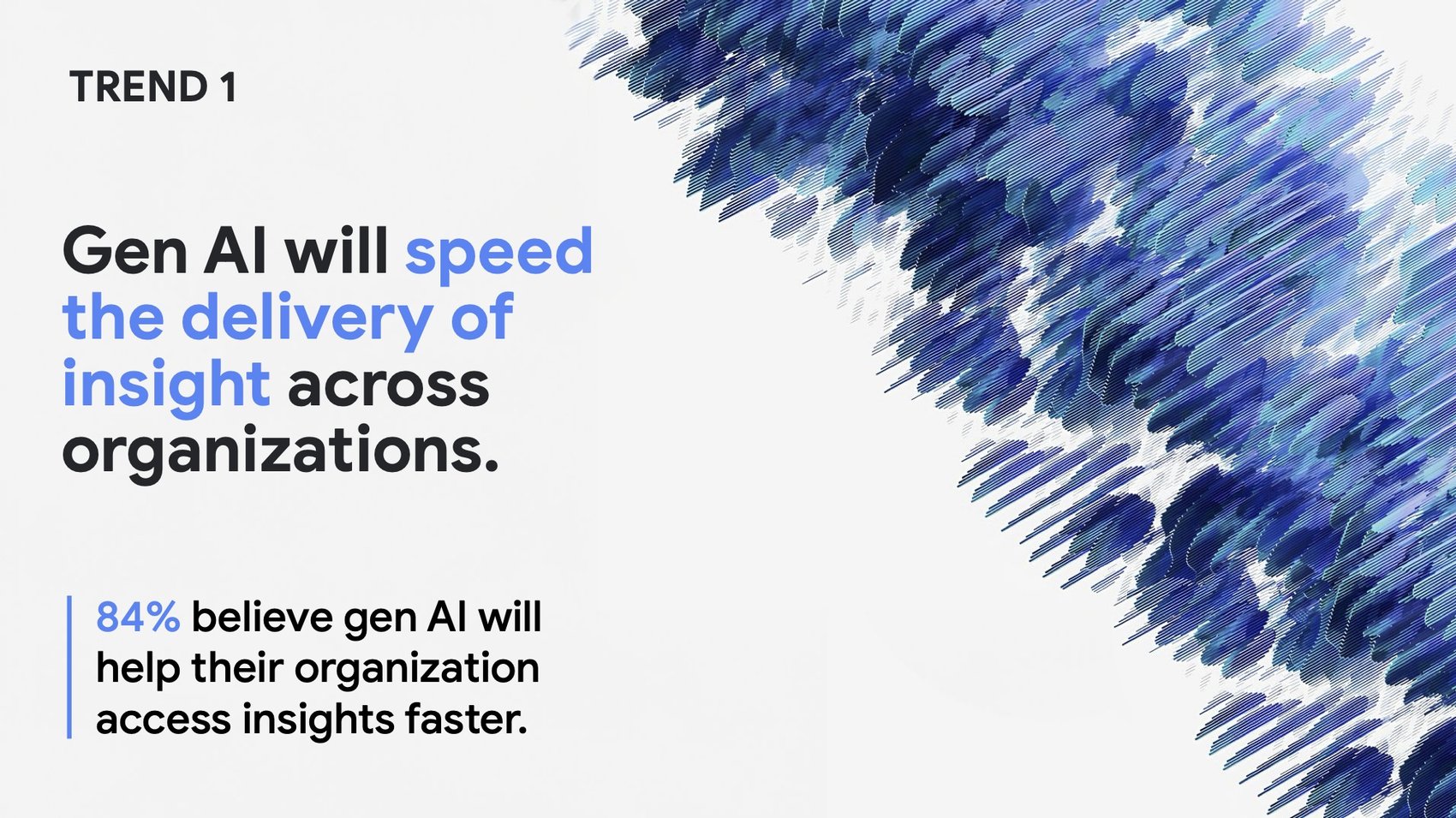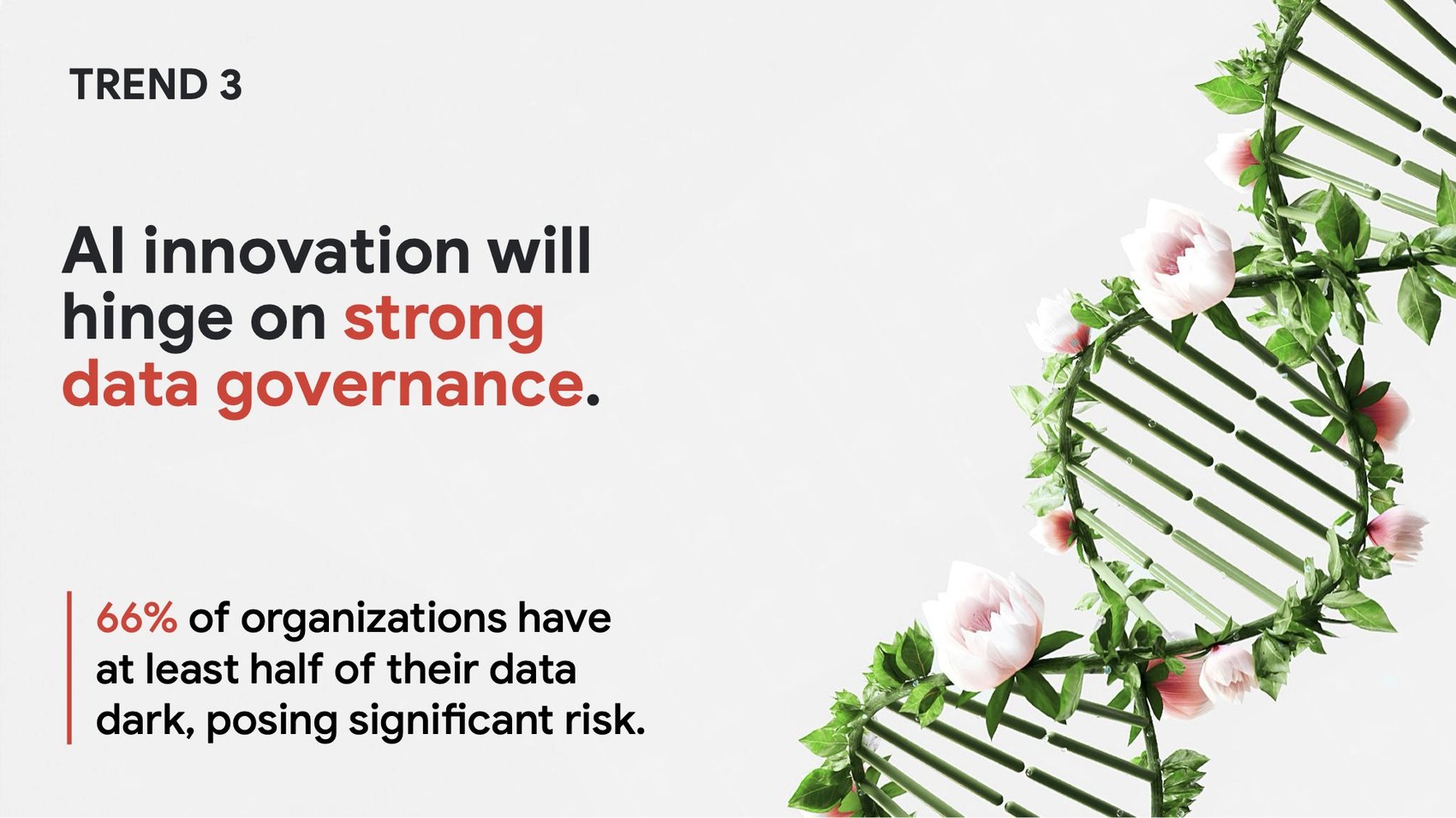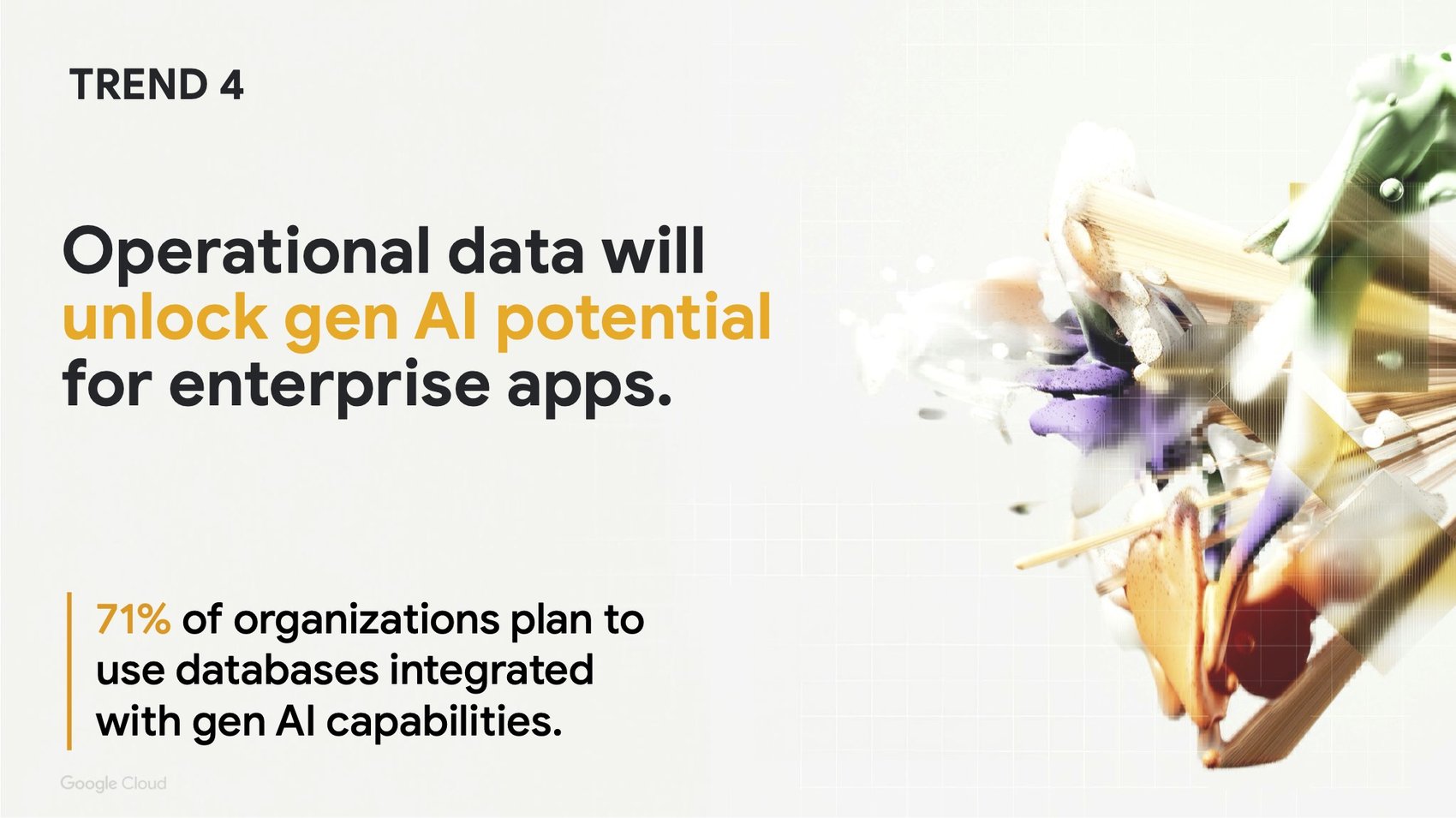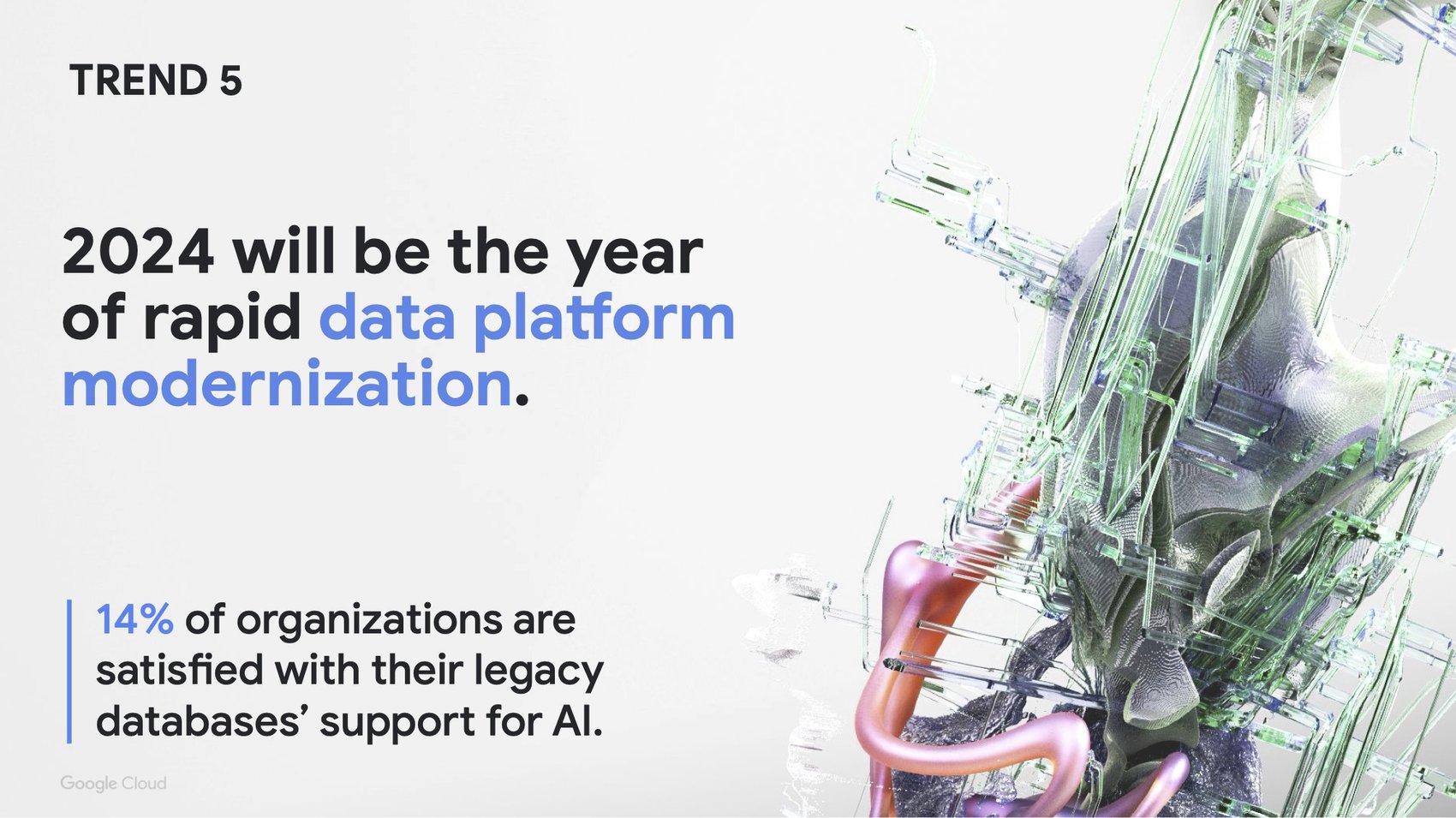Gen AI foundations: Hundreds of execs share the data trends for building better AI

Dain Hansen
Marketing Director, AI and Data Cloud
Five gen AI data trends help unlock more business insights, increase data literacy, secure data assets, and supercharge your capabilities.
Your organization may be ready to embrace generative AI, but is your data?
There’s little doubt that gen AI is here to stay. We’ve already seen just how much power this game-changing technology has to disrupt industries and transform our daily lives, but it comes with a caveat — you’ll need the right data to turn all the AI enthusiasm into tangible business impact.
Like all AI technologies, data is the crucial ingredient that enables gen AI models to learn, reason, predict, and improve output quality over time. And ultimately, future success will likely depend on how well companies cultivate their ability to access, manage, and activate data across enterprise systems, regardless of type or format, according to a new survey from Google Cloud.
Based on interviews with hundreds of data, business, and IT leaders about their strategies and goals for harnessing gen AI, the survey sheds light on where gen AI stands to make the most impact in the coming years. These leaders offer valuable insights about the changes we can expect to play out across the enterprise data stack in the AI era.
As we turn our attention from experimentation to wider AI implementation in 2024, here are five emerging trends you should have top of mind — and what they mean for your organization’s data.


The vast majority of respondents surveyed indicated they expect gen AI to change how fast and, more importantly, who can access organizational data and necessary information. Some 84 percent said they believe gen AI will help accelerate their organization’s access to insights, and nearly two-thirds of data-decision-makers believe gen AI will democratize access to insights.
Gen AI stands to enable everyone — not just experts — to interact with and analyze data. This increases data literacy across your organization, boosts productivity, and empowers more team members to produce new insights instead of having to rely on the availability of specialized skill sets. Already, 52% of non-technical users are leveraging gen AI to gain insights, and many organizations say they see adoption across all lines of business. Marketing, advertising, and PR (62%), sales (47%), operations (42%), and product management (41%) were among the top types of business users already using gen AI to get insights.
The data stack takeaway: Connecting large language models (LLMs) to your business data will help close data and AI skills gaps and allow your workforce to “talk” to data through natural language. These “conversations” can happen in search-based or chat-based interfaces, which can help find information or support the creation of dashboards, reports, and visualizations.


With gen AI enabling new ways to engage with data and AI platforms, 80% of respondents said they see the lines between data and AI roles beginning to blur. Formerly siloed data analytics, engineering, and AI teams are now collaborating more closely than ever before, with many of them seeking the same capabilities to bolster productivity and accelerate the data to AI journey.
Gen AI is also a chance to combat workforce shortages, helping to shore up existing teams so they can keep up with the pace of change. Multimodal models, text embeddings, and other advanced AI and ML technologies are enabling organizations to innovate faster, helping to simplify many of the most time-consuming data to AI processes, redistribute responsibilities, and reimagine workflows.
The data stack takeaway: Bringing AI directly to data can activate its full potential and accelerate how fast you can go from raw data to AI. In particular, multimodal models are unlocking opportunities to tap into all your data — whether it’s structured, semi-structured, or unstructured. As AI adoption increases across your organization, your data and AI tools will need to become increasingly interconnected to streamline data and AI workflows and provide a common workspace for teams to collaborate together.


At the same time, the survey revealed clear concerns about new data vulnerabilities and weaknesses that organizations will need to tackle to avoid certain gen AI security risks, such as hallucinations, data poisoning, or data leakage. Our findings indicate that organizations remain uncertain about whether their data can fully support gen AI use cases, with fewer than half (44%) saying they are fully confident in the quality of their data.
In many cases, this lack of confidence correlates with data governance maturity — most leaders consider their organizations only somewhat mature (54%) and just over a fourth would rate their organizations as extremely or very mature when it comes to data governance.
The data stack takeaway: It’s not enough to just apply LLMs to your data — you’ll need to ground them in good quality enterprise data to support gen AI use cases. Organizations that enable a strong foundation for data governance and compliance from the start will be in a strong position to realize business value and drive better outcomes. The best way to do this is to look for secure-by-design platforms that come with built-in automation and intelligence to provide oversight and help unify governance for data and AI assets.


Enterprise gen AI apps face a variety of challenges from accessing accurate and real-time data to offering contextual, relevant user experiences – and all without being too costly or complex to develop. In the survey, 71 percent of respondents said they are planning to adopt databases integrated with gen AI capabilities, indicating that businesses are looking to find ways to bring LLMs closer to the critical business data needed to make them truly useful for enterprise use cases.
In particular, organizations shared they are looking for operational databases that enable them to seamlessly connect to AI models (45%), use techniques like Retrieval Augmented Generation (RAG) to ground models in trusted data (40%), use natural language for database administration (40%) and code generation (38%). This shift towards gen AI-enabled operational databases will allow developers to build enterprise gen AI apps with latest data and iterate quickly.
The data stack takeaway: Native gen AI capabilities will soon be table stakes in the operational databases you already know and love, making it easier to apply gen AI where your relevant business data already lives. Going forward, successful databases will evolve to be AI-first and deeply integrate technologies, such as vector search, AI model connectivity, natural language to SQL, and tight integrations with AI tooling and open-source frameworks — while those that fail to make this shift will likely become obsolete.


Even as more organizations seek to embrace gen AI, many are struggling with the limitations of their current data platforms, including lagging technology, poor user experience, and millions of dollars in unnecessary costs. Decision-makers cited unfriendly licensing (23%), lack of cloud-first architecture (19%) and integration with cloud services (17%), and vendor lock-in (13%) as the the top challenges holding them back from taking advantage of new gen AI opportunities.
In fact, leaders from almost two out of three organizations (62%) said they feel dissatisfied or neutral about their legacy databases’ support for AI. This indicates just how much database modernization remains a significant hurdle standing in the way of future innovation.
The data stack takeaway: The moment to modernize your data platforms is now. To capture the full potential of the gen AI boom, it’s imperative to have your data where the latest AI tools and most advanced models live and run — and that’s in the cloud. The good news is migrating legacy databases is much easier thanks to improved tools that leverage gen AI. For instance, AI-assisted code conversion and code completion can help simplify migrations, making it much easier to transform your data to fit in a new database.
Looking forward
For decades, data management has been a constant source of headaches in the enterprise, but there’s new urgency to get data foundations in order, once and for all. Harnessing the power of gen AI will require the ability to unify your data, make it accessible for everyone, and provide the latest AI capabilities and technologies needed to transform it into organizational value.
When it comes to exploring gen AI, there’s lots more to unpack. Read the full report for more insights, customer success stories, and practical steps on how to get started.
Opening image created with MidJourney, running on Google Cloud, using the prompt: a cheerful flat magazine-style illustration of a rocket ship blasting off, but instead of fire coming out of its engine, the exhaust is made up of binary code.



